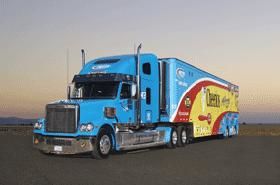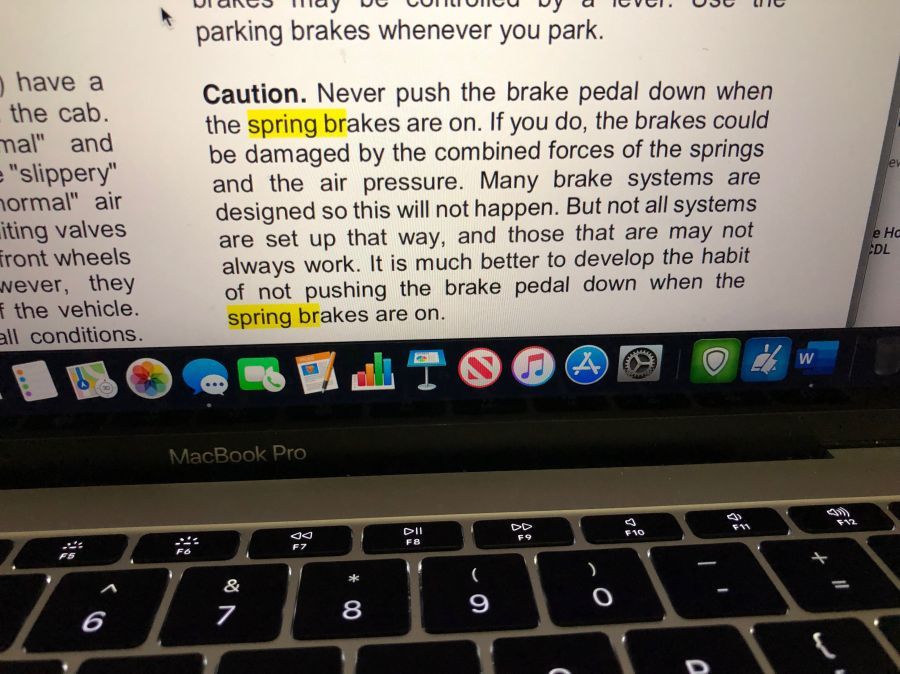Question About Functional External Light Inspection.
Topic 25835 | Page 1
Hi and welcome.
Press the pedal and rhe brake lights come on whether the air brake is engaged or released. So do not pull the air brake. just hit the pedal.
And turn it to on, leaving it off will not allow the gauges to work. The engine does not need to be running but the power needs to.be functional.
good luck
As Rainy said - the brake lights will work even with the spring brakes engaged. Also - you (likely) want to elaborate about the gauges and dash indicator lights working too. Example: when you check the turn signals, you want to make sure the dash indicator lights also work. Same with High Beam, etc. This can be as simple as - I check and observe than all in cab indicators are lit and properly functioning. I think I took a point on the in cab, for missing an indicator light.
And yes - the key needs to be in the ON POSITION (not running) for the gauges to function (obviously).
Rick
Hi everyone,
'm only asking because I can remember reading how it is not good to apply the service brake while the spring brakes are engaged.
Is there any truth to this? I have always put my foot on the service brakes before releasing the parking brakes.
Hi everyone,
'm only asking because I can remember reading how it is not good to apply the service brake while the spring brakes are engaged.
Is there any truth to this? I have always put my foot on the service brakes before releasing the parking brakes.
I've heard this also - don't know that there's any truth to this.
At any rate - you don't need to do a full braking application, to check the brake lights.
Rick

Hi everyone,
'm only asking because I can remember reading how it is not good to apply the service brake while the spring brakes are engaged.
Is there any truth to this? I have always put my foot on the service brakes before releasing the parking brakes.
This is from the Rhode Island CDL manual.
Also, is there a specific order you have to perform each of the tests in? I mean, can you start with your air brake tests, then do parking, and service brakes? Or would you have to start with parking, service, and then finish with air?

CDL:
Commercial Driver's License (CDL)
A CDL is required to drive any of the following vehicles:
- Any combination of vehicles with a gross combined weight rating (GCWR) of 26,001 or more pounds, providing the gross vehicle weight rating (GVWR) of the vehicle being towed is in excess of 10,000 pounds.
- Any single vehicle with a GVWR of 26,001 or more pounds, or any such vehicle towing another not in excess of 10,000 pounds.
- Any vehicle, regardless of size, designed to transport 16 or more persons, including the driver.
- Any vehicle required by federal regulations to be placarded while transporting hazardous materials.

Hi everyone,
'm only asking because I can remember reading how it is not good to apply the service brake while the spring brakes are engaged.
Is there any truth to this? I have always put my foot on the service brakes before releasing the parking brakes.
I've heard this also - don't know that there's any truth to this.
At any rate - you don't need to do a full braking application, to check the brake lights.
Rick
Definitely makes sense. Just erring on the side of caution, I suppose; however, for testing purposes, it's probably the more safe thing to do than releasing the brakes with someone standing behind the vehicle. Thanks

Hi everyone,
'm only asking because I can remember reading how it is not good to apply the service brake while the spring brakes are engaged.
Is there any truth to this? I have always put my foot on the service brakes before releasing the parking brakes.
It’s called “compounding”; meaning too much pressure is applied simultaneously to brake components on the axle(s) with spring brakes installed, that from extended misuse and/or from an excessive amount of force to the pedal,... can cause damage.
Since most newer and well maintained systems are self actuating, it’s less likely to occur with contemporary engineering.
When I first drove heavy 10 wheeled and tri-axle dump trucks in the late 70s, two things were beat into my head while learning; never pump the brakes and once the parking brake is set, never apply any pressure to the service brake pedal.
Even so I would not be make it a common practice. I mean “why” is it necessary to do this? Can’t think of any logical reason.
When you consider how we were all taught to perform the in-cab brake test, my recommendation is NOT to introduce service brake air to a “set” parking/emergency spring brake. Unnecessary. Use chocks for an auto-shift to secure the truck during the bleed-down test.
Hi everyone,
'm only asking because I can remember reading how it is not good to apply the service brake while the spring brakes are engaged.
Is there any truth to this? I have always put my foot on the service brakes before releasing the parking brakes.
It’s called “compounding”; meaning too much pressure is applied simultaneously to brake components on the axle(s) with spring brakes installed, that from extended misuse and/or from an excessive amount of force to the pedal,... can cause damage.
Since most newer and well maintained systems are self actuating, it’s less likely to occur with contemporary engineering.
When I first drove heavy 10 wheeled and tri-axle dump trucks in the late 70s, two things were beat into my head while learning; never pump the brakes and once the parking brake is set, never apply any pressure to the service brake pedal.
Even so I would not be make it a common practice. I mean “why” is it necessary to do this? Can’t think of any logical reason.
When you consider how we were all taught to perform the in-cab brake test, my recommendation is NOT to introduce service brake air to a “set” parking/emergency spring brake. Unnecessary. Use chocks for an auto-shift to secure the truck during the bleed-down test.
I meant when I am ready to start moving. And I don’t press hard, don’t need to just to keep it from rolling.

I meant when I am ready to start moving. And I don’t press hard, don’t need to just to keep it from rolling
Once you push both valves (red and yellow), the spring brake releases once air pressure builds. It’s not instant; so releasing the parking/emergency brakes and almost immediately pressing the service brake to hold the truck is totally acceptable.
New Reply:
New! Check out our help videos for a better understanding of our forum features

















Preview:
This topic has the following tags:
Advice For New Truck Drivers High Road Training Program Pre-trip inspection (PTI) TT Website







 TT On Facebook
TT On Facebook
Hi everyone,
New to the forum, but have been reading various threads for quite sometime to gain information about different topics.
In any event, I am taking my CDL class B road test in a few weeks (smaller model Mack dump truck; 22 feet in length; equipped with air brakes). I live out in Rhode Island.
My question is concerning the portion of the exam where you have to tell the examiner which lights you will be switching on from the cab, and you are relying on him/her to tell you they are properly functioning.
When performing the rear service brake light check, do you have to disengage the parking brake? Wouldn't that considered unsafe if the examiner is standing behind the vehicle and the parking brake is released? I'm only asking because I can remember reading how it is not good to apply the service brake while the spring brakes are engaged. What is the proper procedure for this?
EXTRA QUESTION When performing your in-cab air brake tests, testing for static and applied pressure leakage, does the ignition have to be completely switched to OFF, or does it have to be in the ACC/electrical position? Can the air gauges still work when the key is in the OFF position? Does this procedure vary state to state?
Thank you
CDL:
Commercial Driver's License (CDL)
A CDL is required to drive any of the following vehicles: